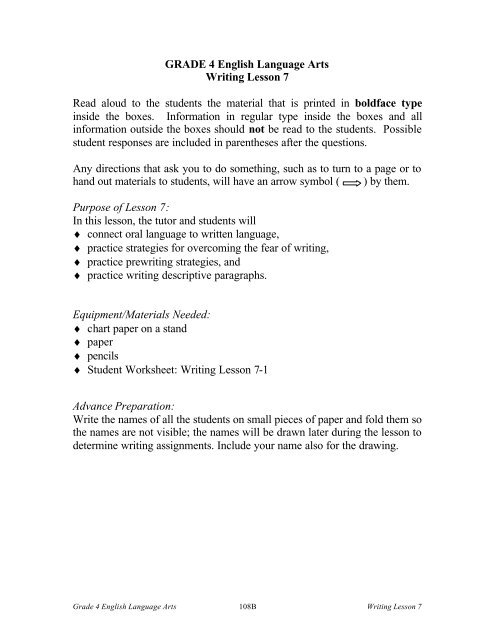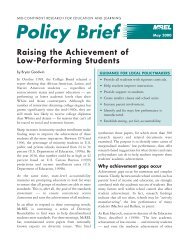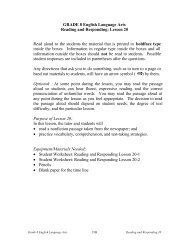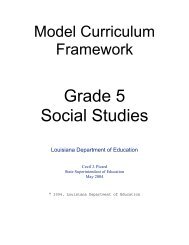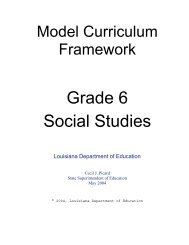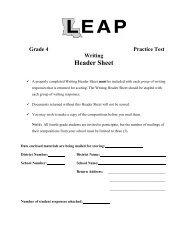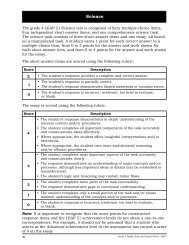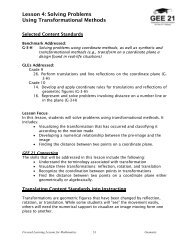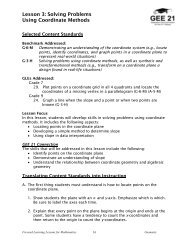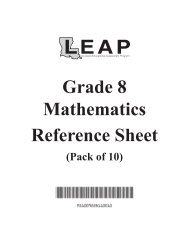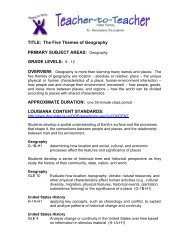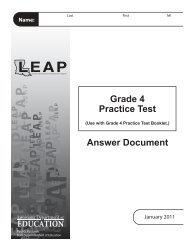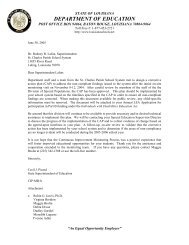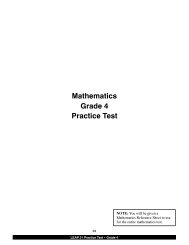GRADE 4 English Language Arts Writing Lesson 7 Read aloud to ...
GRADE 4 English Language Arts Writing Lesson 7 Read aloud to ...
GRADE 4 English Language Arts Writing Lesson 7 Read aloud to ...
You also want an ePaper? Increase the reach of your titles
YUMPU automatically turns print PDFs into web optimized ePapers that Google loves.
<strong>GRADE</strong> 4 <strong>English</strong> <strong>Language</strong> <strong>Arts</strong><strong>Writing</strong> <strong>Lesson</strong> 7<strong>Read</strong> <strong>aloud</strong> <strong>to</strong> the students the material that is printed in boldface typeinside the boxes. Information in regular type inside the boxes and allinformation outside the boxes should not be read <strong>to</strong> the students. Possiblestudent responses are included in parentheses after the questions.Any directions that ask you <strong>to</strong> do something, such as <strong>to</strong> turn <strong>to</strong> a page or <strong>to</strong>hand out materials <strong>to</strong> students, will have an arrow symbol ( ) by them.Purpose of <strong>Lesson</strong> 7:In this lesson, the tu<strong>to</strong>r and students will♦ connect oral language <strong>to</strong> written language,♦ practice strategies for overcoming the fear of writing,♦ practice prewriting strategies, and♦ practice writing descriptive paragraphs.Equipment/Materials Needed:♦ chart paper on a stand♦ paper♦ pencils♦ Student Worksheet: <strong>Writing</strong> <strong>Lesson</strong> 7-1Advance Preparation:Write the names of all the students on small pieces of paper and fold them sothe names are not visible; the names will be drawn later during the lesson <strong>to</strong>determine writing assignments. Include your name also for the drawing.Grade 4 <strong>English</strong> <strong>Language</strong> <strong>Arts</strong> 108B <strong>Writing</strong> <strong>Lesson</strong> 7
Introduction:Before we begin our writing activity, let's review some importantpoints about writing.First of all, what is the purpose or reason for writing? Pause. (<strong>to</strong> give amessage)What is one strategy for overcoming the fear of writing? Pause.(pretend <strong>to</strong> tell about something before writing about it) Yes, remember:what you can talk about, you can write about; what you can write about,someone can read about.What is the first step in any writing assignment? Pause. (getting yourthoughts written down on paper without worrying about everything beingperfect)What should you do if you don't know how <strong>to</strong> spell the words you want<strong>to</strong> include in your writing? Pause. (spell them the best you can and markthem so you won't forget <strong>to</strong> go back and check for correct spelling) If youworry <strong>to</strong>o much about writing perfectly, you might forget about yourgood ideas for writing down your thoughts.After you have written your thoughts down in complete sentences,what should you do next? Pause. (Reread what you wrote <strong>to</strong> be sure yoursentences connect and make sense; rewrite sentences that don't make sense)What is the next step? Pause. (proofread for spelling and punctuationerrors and make corrections)Distribute Student Worksheet: <strong>Writing</strong> <strong>Lesson</strong> 7-1.Here is a list of important things <strong>to</strong> remember about writing. If you donot have your copy from the last lesson, you can use this one <strong>to</strong> helpyou remember these things when you do the next writing activity.Grade 4 <strong>English</strong> <strong>Language</strong> <strong>Arts</strong> 109B <strong>Writing</strong> <strong>Lesson</strong> 7
For <strong>to</strong>day's writing lesson, we will play a game. Do any of you knowhow <strong>to</strong> play the game I Spy? Pause; ask students who respond yes <strong>to</strong>explain how <strong>to</strong> play the game. Then paraphrase or clarify as needed.For those of you who may not know how <strong>to</strong> play this game, it is reallysimple. One person describes an object in the room while the othersguess what it is. Describe an object in the room <strong>to</strong> illustrate the game. Forexample, I might say, "I spy something green, dusty, big, and shapedlike a rectangle." Does anyone know what it is? Pause (the chalkboard)This one wasn't <strong>to</strong>o difficult <strong>to</strong> find because I gave you lots of clues.How many clues did I give? Pause. (four) What if I had given you onlyone clue and said, "I spy something big"? Would this object have beeneasy <strong>to</strong> find? (No, because there are many big things in this room; wewouldn't know which one you meant.)Describe any white object in the room by using only the word white fordescription. Let's do another one. "I spy something white." What is it?Pause. (Students should guess several times before finding the object,because there will be so many white objects in the room. After the objecthas been identified, discuss the reasons for the difficulty in doing so. Whywas this object difficult <strong>to</strong> find? Pause. (There are so many white things inthis room; we don't have enough clues.)It's easy <strong>to</strong> see why it is important <strong>to</strong> give lots of details when you aredescribing something. The more details you give, the easier it is <strong>to</strong> get amental picture of it. A mental picture is the picture we have in our headswhen we imagine something.Our assignment <strong>to</strong>day is <strong>to</strong> write a description of someone. Before youget started on this assignment, I am going <strong>to</strong> describe a boy. Help methink of some things I might include in my description. Thinking ofideas before writing is sometimes called brains<strong>to</strong>rming. Help mebrains<strong>to</strong>rm ideas for writing a description of someone.Grade 4 <strong>English</strong> <strong>Language</strong> <strong>Arts</strong> 110B <strong>Writing</strong> <strong>Lesson</strong> 7
Write the following list on the chalkboard, including any student suggestionsthat are appropriate.- his age- how he looks (hair, eyes, skin)- kind of clothes he usually wears- things he likes <strong>to</strong> do- interesting or different things about himNow I have something <strong>to</strong> help me remember what I will write about thisboy. If I think of something else, I will add it. The list is just <strong>to</strong> help meget started.Using a think <strong>aloud</strong> approach, write the following on the chalkboard.First I want <strong>to</strong> talk about his age and his size. I have a picture of him inmy mind and will try <strong>to</strong> describe it. I will indent the first line because Iam beginning a paragraph. Then I will talk about how he spends histime.When I think of this ten-year old boy, I see someone who alwaysseems <strong>to</strong> be moving. With a smile on his face, he is often seen running withhis friends, either chasing something, or being chased. He is small andslender, but you should not be fooled by his size. Even though he is muchshorter and smaller than most of his friends, he is very lean, muscular, andstrong. He can run, jump, climb, and swim all day without ever seeming <strong>to</strong>get tired. He would probably do well playing many kinds of sports.(After writing the above on the board, read it <strong>aloud</strong>.)Now I need <strong>to</strong> read my description <strong>aloud</strong> <strong>to</strong> make sure it makes sense.<strong>Read</strong> the paragraph <strong>aloud</strong>. Does this paragraph make sense? Can anyoneguess who I am describing? Pause. (Mowgli, from Jungle Book)If students do not guess correctly, do not tell them the answer before readingthe next paragraph.Grade 4 <strong>English</strong> <strong>Language</strong> <strong>Arts</strong> 111B <strong>Writing</strong> <strong>Lesson</strong> 7
(<strong>Read</strong> the second paragraph about Mowgli, below.)To see what this boy's face looks like, you have <strong>to</strong> see him when he isstill. The only time he is still is during the night when he is sound asleepafter a long day with his friends. Then, if his dark brown, tangled hair isn'thiding his face, you can see that his face is almost as dark as his hair. Likehis arms and long legs, his face is a very dark, brown color, partly becausehe spends so much time outside. In fact, he sleeps outside under the trees, orsometimes in a cave.Since I have given more clues now, can anyone figure out whom thisparagraph describes? Pause (Mowgli)Now I think you are ready <strong>to</strong> write your descriptive paragraphs. Firstwe need <strong>to</strong> decide whom you will describe. To do this, we will drawnames. My name will be drawn also, because I will do the same writingassignment you will do.Place the folded pieces of paper with names written on them in a containerand ask each child <strong>to</strong> draw one; then you can draw the last name.When you draw a name, carefully unfold the paper without allowingothers <strong>to</strong> see whose name you have drawn. If you draw your name, youmust put it back and draw another.After each student has drawn a name, give the following instructions.Your assignment is <strong>to</strong> describe the person whose name you have drawn.You must write at least one paragraph with at least five sentences. Ifyou would like <strong>to</strong> write more than one paragraph, you may.Remember <strong>to</strong> use the list of important things <strong>to</strong> remember aboutwriting that I gave you earlier. Be sure that you have gone througheach step. When we have finished writing our descriptive paragraphs,we will take turns reading them <strong>aloud</strong>. After each student has read hisor her paragraph <strong>aloud</strong>, the rest of us will try <strong>to</strong> figure out whom theparagraph describes.Grade 4 <strong>English</strong> <strong>Language</strong> <strong>Arts</strong> 112B <strong>Writing</strong> <strong>Lesson</strong> 7
While the students are writing their paragraphs, circulate among them <strong>to</strong>encourage and assist as needed. You may have <strong>to</strong> prompt some students <strong>to</strong>get them started. If a student doesn't know what <strong>to</strong> write, ask her <strong>to</strong> tell youwhat the person looks like. Listen <strong>to</strong> her describe the person and prompt her<strong>to</strong> elaborate.After most of the students have written their paragraphs, begin allowingthem <strong>to</strong> read their descriptions while others try <strong>to</strong> identify the person.Grade 4 <strong>English</strong> <strong>Language</strong> <strong>Arts</strong> 113B <strong>Writing</strong> <strong>Lesson</strong> 7
Student Worksheet: <strong>Writing</strong> <strong>Lesson</strong> 7-1<strong>Writing</strong>: Sending a Message♦ overcoming the fear♦ remembering the purpose♦ getting started♦ getting finishedStep 1: Write down your important thoughts first. Think about whatyou really want <strong>to</strong> say; write down these important thoughts. Don't worryabout spelling or writing in complete sentences at first; just write the wordsthe best you can, and write in short phrases or sentences. Remember, thepurpose of writing is <strong>to</strong> send a message.Step 2: Organize your thoughts in<strong>to</strong> main ideas. Use an outline or as<strong>to</strong>ry map <strong>to</strong> organize your s<strong>to</strong>ry in<strong>to</strong> sections with main ideas andsupporting details.Step 3: Rewrite your thoughts in complete sentences. Be sure yoursentences connect and are in an order that makes sense. Be sure your mainidea has details that support it.Step 4: <strong>Read</strong> what you have written; revise. The most important thingabout your writing is that it makes sense. If necessary, rewrite sentences <strong>to</strong>make better sense or provide more details. If possible, ask another person<strong>to</strong> read what you wrote <strong>to</strong> make sure it makes sense.Step 5: Proofread for errors. After being sure that your writing makessense, look carefully at it <strong>to</strong> check for correct spelling and punctuation.Step 6: Correct spelling and punctuation errors. Do the best you can <strong>to</strong>find all of your errors and correct them.If you can say it, you can write it. If you can write it, someone can read it.<strong>Writing</strong> your thoughts on paper is just another way of saying something.Note. Developed for Middle School <strong>Read</strong>ing/<strong>Writing</strong> Workshop, November, 2000, byDeidra Frazier. Reprinted with permission.Grade 4 <strong>English</strong> <strong>Language</strong> <strong>Arts</strong> 114B <strong>Writing</strong> <strong>Lesson</strong> 7


